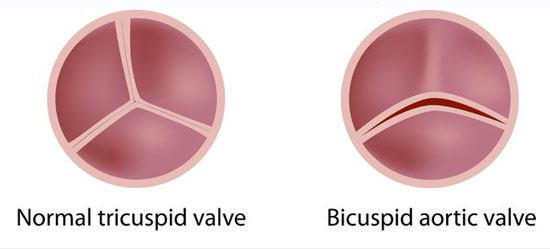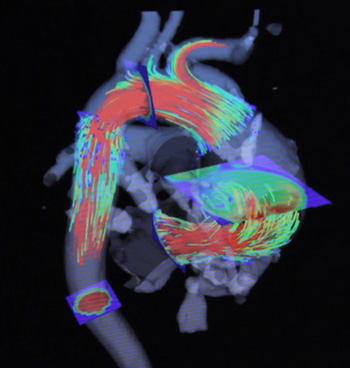Technology Update: Using 4D-MRI to Advance Bicuspid Aortic Valve Therapy
Written By: Adam Pick, Patient Advocate & Author
Medical Expert: Paul Fedak, MD
Page Last Updated: May 12, 2025
Like many of you, I was born with a bicuspid aortic valve. For that reason, I’m overly interested to learn more about this valvular disorder that impacts 2% of the population.
Recently, I had a special opportunity to meet and interview Dr. Paul Fedak, a cardiac surgeon, scientist and Director of Translational Research at the Northwestern Bicuspid Aortic Valve Disease Program. As you will see in this video, Dr. Fedak and his team is using the latest technology, 4D-MRI, to better understand and treat bicuspid aortic valves.
I hope this helped you learn more about bicuspid aortic valves, aortic aneurysms and the research going on at Northwestern to improve bicuspid aortic valve treatment. I’d like to extend a special thanks to Dr. Paul Fedak and the Bicuspid Aortic Valve Program at Northwestern for all of their incredible work.
Transcript of My Video Interview with Dr. Paul Fedak
For the hearing impaired members of our community, I have provided you a written transcript of this video interview with Dr. Fedak below:
Dr. Fedak says: Hi. My name is Dr. Paul Fedak. I’m a Cardiac Surgeon and a scientist, and I’m the Director of Translational Research here at the Northwestern Bicuspid Aortic Valve Disease Program. My specialty – I do a fair bit of general cardiac surgery, but my practice is growing in valves by the day. I have a research interest in bicuspid aortic valve disease, so I’m always happy to operate on patients with bicuspid aortic valves so I can better understand their disease and better help those specific patients.

I became interested in cardiac surgery actually, after I was accepted to medical school. I saw patients who couldn’t walk across their hospital room. They would go into surgery and have a three or four hour valve surgery, and a week later they were running and breathing normally and had their life back. To me that was a very captivating experience to see how the cardiac surgeons could really turn these patients around symptomatically.
A bicuspid aortic valve has two flaps instead of three. Typically a patient would be born with a tricuspid valve, meaning they have three flaps that make up their aortic valve. If you’re born with a bicuspid aortic valve it can tend to wear out over time. So we see patients typically in their 40’s or 50’s who maybe come in with a leaky heart valve or a stenotic heart valve, meaning that the valve starts to become calcified and less pliable and thickened, and then it prevents blood from easily leaving the heart.
The flow through the valve is abnormal. So if you pictured a faucet, and water coming out of your faucet, it comes out in what we call laminar flow. It comes out kind of straight in an organized fashion, but even if you were to take your finger and just put it slightly into the stream, what would happen? You’d have chaos, there’s water splashed everywhere. It’s the same thing with a bicuspid aortic valve. So your aortic root is specially designed, we have nice clear laminar flow through it.

With two flaps instead of three there’s always a little bit of obstruction to the flow. That chaos results in stress and strain in the aortic wall which may result in a patient’s aorta enlarging over time. Here at Northwestern, we’re doing some studies where we’re taking 4D MRI technology where we can actually look into you and see where those stresses and strains are during the cardiac cycle, and how we can best treat those patients before a catastrophic complication occurs. These patients should be closely monitored. The more specialized the center, such as the Center for Bicuspid Aortic Valve Disease that we have here at Northwestern where you assemble a group of experts who can really follow you and give you the best possible patient care and monitor you for these complications, the better.
The last thing I would suggest is please participate in research. There’s a lot of questions that we have about bicuspid aortic valve disease. Not only will you help yourself by participating in a research programs like ours, but you’ll help other patients with bicuspid aortic valve disease. There’s a lot to learn, and if you participate in research you’ll help yourself and others in the future.
Related Link:
- Cardiac Innovation: 4D MRI Flow Predicts Aneurysm Risks
- Patient Success Story: Using 4D MRI to Time John’s Heart Valve Surgery
Keep on tickin!
Adam
|
nancy says on January 24th, 2014 at 3:29 pm |
|
I am very interested in finding out who else does a 4D MRI heart image? I have a BAV that is stenotic and is severely leaking, The doctors I have seen in MN can’t seem to get good images of my heart to determine condition of valve. I am interested in know knowledgeable doctors that can treat this condition hopefully not too far away. I live in the Twin Cities. Thanks for the story. |
 |
|
Michelle Johnson says on January 25th, 2014 at 10:20 am |
|
My 9 1/2 yr old son has a bicuspid aortic valve. No stenosis or anything. Mildly dilated aortic root. He active and into his sports and would like to stay that way as long as possible. Is there any facilities that you know of in the South jersey or Philadelphia area that not only does 4D imagining but also specializes in this condition. |
 |
|
claude campbell says on January 27th, 2014 at 7:32 am |
|
Thanks |
 |
|
claude campbell says on January 27th, 2014 at 7:35 am |
|
would like to no more on this I have A-F DOC SAID……….. |
 |
|
Michele says on January 28th, 2014 at 5:39 pm |
|
I am also interested in 4D MRI imaging. I have a BAV and my cardiologist wants me to have a TEE to get a better image of my heart. Wanting to avoid anesthesia whenever possible, I wonder if I could undergo a 4D MRI instead? |
 |










